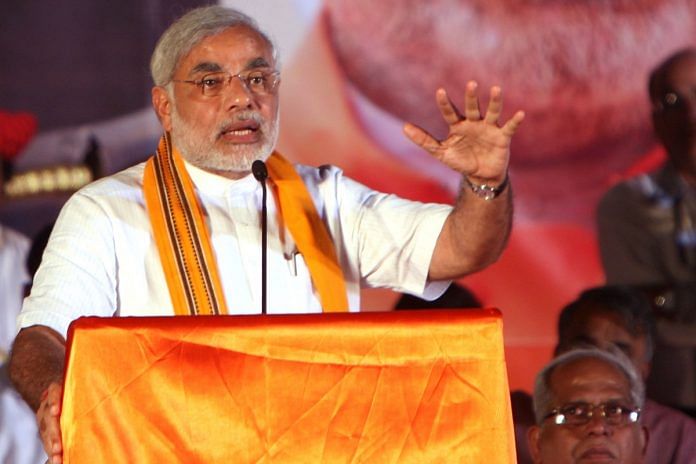By spreading the benefits of OBC reservations more evenly among all OBCs, the BJP can win over 40 crore of India’s most deprived people.
New Delhi: The formation of a panel to examine the sub-categorisation of other backward classes (OBCs) is ostensibly to ensure that the more backward among the communities can access the benefits of reservation. But the move by the Narendra Modi government has strong political undertones.
Over the years, 11 states have brought sub-categorisation into the state list for employment. But the Modi government is aiming much higher ahead of the 2019 Lok Sabha elections – it wants to sub-categorise the Central list of 5,000 castes.
This move could help the BJP go beyond its ‘Brahmin-Baniya party’ image, and win over a 40 crore-strong vote bank.
Sixty per cent of India’s population, or around 70 crore people, are categorised as OBCs. Of these, political analysts estimate that about 40 crore form the ‘most deprived’ class of OBCs, with poor access to an improved life.
Regional and caste group-specific parties have often targeted the more influential sections among the OBCs, and these sections have cornered a bulk of the 27 per cent OBC quota, leaving other sections high and dry. These people are the BJP’s main focus.
While the current ambit of the scheme is limited to central government jobs, the Modi regime could also follow the lead of Bihar’s Nitish Kumar government, which has extended the benefits of the sub-categorisation of 131 OBC castes to social schemes too.
Welfare politics
The new quota-within-quota for OBCs is the second part of the BJP’s outreach strategy, after the Dalit campaign that Modi & Co. built around B.R. Ambedkar. It has the potential to unleash a ripple effect across states that could upset electoral calculations in unpredictable ways.
In a precursor to the latest move, the government had, in 2016, raised the creamy layer limit for OBCs from Rs 6 lakh per annum to Rs 8 lakh.
However, the politics behind the latest move is not a novel strategy. Sub-categorisation was being mentioned as early as the UPA-I regime, and the Congress went on to introduce OBC sub-categorisation in many states.
It gave similar political signals just ahead of the 2014 Lok Sabha elections, when PM Manmohan Singh and the social justice ministry nudged the National Commission for Backward Classes (NCBC) on the issue. The latter submitted its report in March 2015, recommending sub-classification into three categories – ‘extremely backward classes’ such as aboriginal tribes, ‘more backward classes’ engaged in vocational groups, and ‘backward classes’ involved in agriculture and business.
PM Modi, however, has moved beyond signals. The announcement of a committee to look into OBC sub-categorisation and submit its report within 12 weeks shows that the BJP means business.
Political ripples
Researchers associated with discussions on this matter since the UPA days told ThePrint that it was a “win-win situation” for the BJP.
“There are considerable political implications and these are not limited to just two or three states. This will be nationwide,” an eminent researcher told ThePrint on the condition of anonymity.
“What it will help do is spread out the benefits of the 27 per cent OBC quota well enough among all castes and sub-castes in proportion to their population. If those excluded do not vote for the BJP, those included surely will.”
Sanjay Kumar, director, Centre for the Study of Developing Societies (CSDS), added: “At the same time, by increasing the upper limit for the creamy layer from Rs 6 lakh to Rs 8 lakh, the party has expanded the scope of the new policy for dominant OBC castes such as the Yadavs.”
In a recent interview to ThePrint, Bhupender Yadav, BJP general secretary, had spoken about giving constitutional status to the OBC Commission, and predicted its huge implications.
“It will impact the entire country because it is a major step towards social justice and a long-awaited demand of the OBC community,” he said.
“This is a fight for social justice that was left unfinished because of the Congress. The constitutional amendment issue was first mentioned in 2001 in the Handique committee report, but the Congress did not act on it for the last 70 years, or even for the last 10 years.”
A senior Congress leader who has studied the issue conceded that the move would have huge social and political implications, but added that the BJP was guided by a divisive agenda.
“We firmly believe that the disparities in accessing of educational and other economic and social benefits must be ended, and the Congress has effected the sub-quota in several states,” he said.
“The sad part, however, is that the BJP is moving on this with a divisive agenda in mind – only to divide the caste segments. If they truly want to work for the entire segment, why are they not doing away with the creamy layer ceiling, since the quota isn’t even getting filled?”
With inputs from Kumar Anshuman



